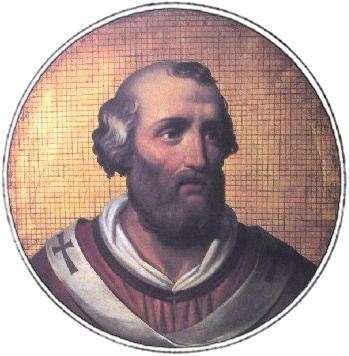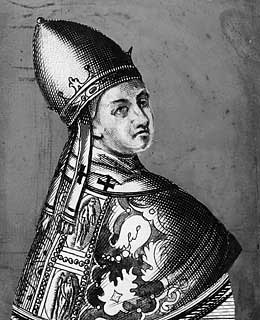<Back to Index>
- Pope John XII, 955-964
- Pope Benedict IX, 1032-1048
PAGE SPONSOR

Pope John XII (c. 937 – 14 May 964), born Octavianus, was Pope from 16 December 955 to 14 May 964. The son of Alberic II, Patrician of Rome, and his stepsister Alda of Vienne, he was a seventh generation descendant of Charlemagne on his mother's side.
Before his death in 954, Alberic administered an oath to the Roman nobles in St. Peter's providing that the next vacancy for the papal chair would be filled by his son Octavianus. He succeeded his father as Patrician of Rome in 954 at only seventeen years of age. After the death of Agapetus II in November 955, Octavanius was actually chosen his successor on 16 December 955 at the age of eighteen. His adoption of the apostolic name of John XII was the third example of taking a regnal name upon elevation to the papal chair, the first being John II (533 – 535) and the second John III (561 - 574). Pope John XII was depicted as a coarse, immoral man in the writings which remain about his papacy, whose life was such that the Lateran was spoken of as a brothel, and the moral corruption in Rome became the subject of general disgrace.
An account is given in Patrologia Latina of the charges leveled against him:
Then, rising up, the cardinal priest Peter testified that he himself had seen John XII celebrate Mass without taking communion. John, bishop of Narni, and John, a cardinal deacon, professed that they themselves saw that a deacon had been ordained in a horse stable, but were unsure of the time. Benedict, cardinal deacon, with other co-deacons and priests, said they knew that he had been paid for ordaining bishops, specifically that he had ordained a ten year old bishop in the city of Todi... They testified about his adultery, which they did not see with their own eyes, but nonetheless knew with certainty: he had fornicated with the widow of Rainier, with Stephana his father's concubine, with the widow Anna, and with his own niece, and he made the sacred palace into a whorehouse. They said that he had gone hunting publicly; that he had blinded his confessor Benedict, and thereafter Benedict had died; that he had killed John, cardinal subdeacon, after castrating him; and that he had set fires, girded on a sword, and put on a helmet and cuirass. All, clerics as well as laymen, declared that he had toasted to the devil with wine. They said when playing at dice, he invoked Jupiter, Venus and other demons. They even said he did not celebrate Matins at the canonical hours nor did he make the sign of the cross.
Enemies defeated him in battle and occupied lands that belonged to the popes. In order to protect himself against the intrigues in Rome and the power of Berengar II of Italy, John made a deal with Otto I, king of the Germans. He pledged allegiance to Otto and crowned him emperor of the Holy Roman Empire on 2 February 962. In return, Otto promised to recognize only John as pope. Ten days later, the pope and emperor ratified the Diploma Ottonianum, under which the emperor became the guarantor of the independence of the papal states. This was the first effective guarantee of such protection since the Carolingian Empire. After Otto left Rome and reconquered the Papal States from Berengar, however, John became fearful of the emperor's power and sent envoys to the Magyars and the Byzantine Empire to form a league against Otto. His intrigues were discovered by Otto I, who, after defeating and imprisoning Berengar II, returned to Rome. Otto I subsequently summoned a council which deposed John XII, who was in hiding in the mountains of Campania, and elected Pope Leo VIII in his stead.
An attempt at a revolt was mounted by the inhabitants of Rome even before Otto I left the city. Upon his departure, John XII returned at the head of a formidable company of friends and retainers, thus causing Leo VIII to seek safety in immediate flight. The Emperor determined to make an effort in support of Leo VIII, but before he reached the city John XII had died.
Pope Benedict V soon succeeded him, but he was successfully deposed by Leo VIII.
Onofrio Panvinio, in the revised edition of Bartolomeo Platina's book about the popes, added an elaborate note indicating that the legend of Pope Joan may be based on a mistress of John XII: Panvinius,
in a note to Platina's account of pope Joan, suggests that the
licentiousness of John XII, who, among his numerous mistresses, had one
called Joan, who exercised the chief influence at Rome during his
pontificate, may have given rise to the story of "pope Joan."

Pope Benedict IX (c. 1012 – c. 1056), born in Rome as Theophylactus of Tusculum, was Pope on three occasions between 1032 and 1048. One of the youngest popes, he was the only man to have been Pope on more than one occasion and the only man ever to have sold the papacy.
Benedict was born the son of Alberic III, Count of Tusculum, and was a nephew of Pope Benedict VIII and Pope John XIX. His father obtained the Papal chair for him, granting it to his son in October 1032.
According to the Catholic Encyclopedia and other sources, Benedict IX was around 18 to 20 years old when made pontiff, although some sources claim 11 or 12. He reportedly led an extremely dissolute life and allegedly had few qualifications for the papacy other than connections with a socially powerful family, although in terms of theology and the ordinary activities of the Church he was entirely orthodox. St. Peter Damian is alleged to have described him as "feasting on immorality"; the anti - papal historian Ferdinand Gregorovius wrote that in Benedict, "a demon from hell in the disguise of a priest... occupied the chair of Peter and profaned the sacred mysteries of religion by his insolent courses." The Catholic Encyclopedia calls him "a disgrace to the Chair of Peter." The first pope said to have been primarily homosexual, he was said to have held orgies in the Lateran palace.
He was also accused by Bishop Benno of Piacenza of "many vile adulteries and murders". Pope Victor III, in his third book of Dialogues, referred to "his rapes, murders and other unspeakable acts. His life as a pope so vile, so foul, so execrable, that I shudder to think of it."
He was briefly forced out of Rome in 1036, but returned with the help of Emperor Conrad II.
In September 1044 the opposition forced him out of the city again and elected John, Bishop of Sabina, as Pope Sylvester III. Benedict IX's forces returned in April 1045 and expelled his rival, who however kept his claim to the papacy for years.
In May 1045, Benedict IX resigned his office to pursue marriage, selling his office to his godfather, the pious priest John Gratian, who named himself Gregory VI.
Benedict IX soon regretted his resignation and returned to Rome, taking the city and remaining on the throne until July 1046, although Gregory VI continued to be recognized as the true pope. At the time, Sylvester III also restated his claim.
German King Henry III intervened, and at the Council of Sutri in December 1046 Benedict IX and Sylvester III were declared deposed while Gregory VI was encouraged to resign, which he did. The German Bishop Suidger was crowned Pope Clement II.
Benedict IX had not attended the council and did not accept his deposition. When Clement II died in October 1047, Benedict seized the Lateran Palace in November, but was driven away by German troops in July 1048. To fill the power vacuum, bishop Poppo of Brixen was elected as Pope Damasus II and universally recognized as such. Benedict IX refused to appear on charges of simony in 1049 and was excommunicated.
Benedict IX's eventual fate is obscure, but he seems to have given up his claims to the papal throne. Pope Leo IX may have lifted the ban on him. Benedict IX was buried in the Abbey of Grottaferrata c. 1056 according to some accounts.
Benedict is usually recognized as having had three terms as pope:
- the first lasting from his election to his expulsion in favor of Sylvester III (October 1032 – September 1044)
- the second from his return to his selling the papacy to Gregory VI (April – May 1045)
- the third from his return after the death of Clement II to the advent of Damasus II. (November 1047 – July 1048)